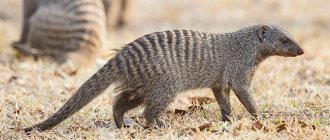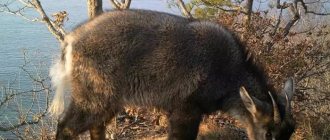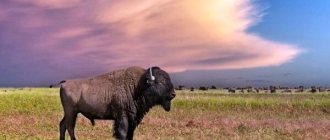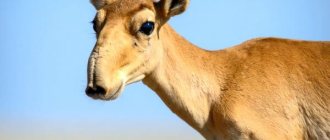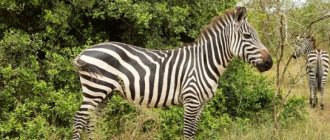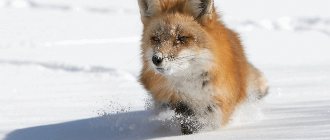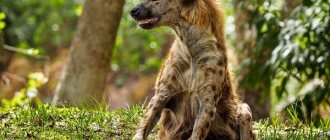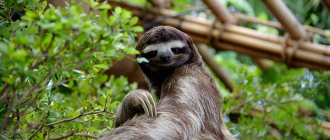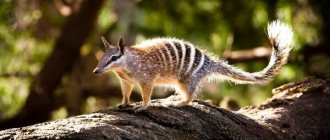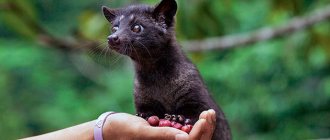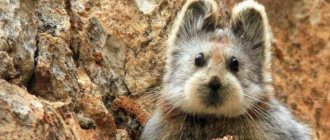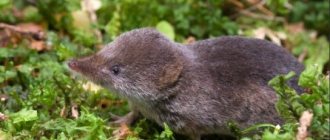- Wild animals
- >>
- Mammals
Either a cat or a bear - zoo visitors just can’t figure out which one the binturong ? This fur-bearing animal with a long tail and mustache is somewhat reminiscent of a raccoon, and at the same time can grunt like a pig. But still, this charmer has nothing to do with the listed animals. This is a completely special, independent species, interest in which has been growing and growing in recent years.
Origin of the species and description
Photo: Binturong
Having cat-like habits and a clubbed bear-like gait, the binturong nevertheless comes from the civet family. Although the binturong still has common roots with the cat family, they go back to the early Paleogene era. The Latin name for the predator is Arctictis binturong. All representatives of this family have similar features: a slender body, a long tail and short legs.
Outwardly, they resemble mustelids, or felines, with a flexible, muscular body, medium-sized neck and long muzzle. The ears are usually set wide apart and the eyes are large. Limbs with five fingers. Viverrids are digitigrade and plantigrade. In total, this family includes 35 species, which are combined into 15 genera and 4 subfamilies. Many of the species are poorly studied.
Video: Binturong
The binturong has 6 recognized subspecies and another 3 unrecognized. Subspecies of binturong, for example, from Indonesia or from the Philippine Islands, have extremely limited habitats, so they are not included in the official list of subspecies:
- binturong albifrons;
- binturong binturong;
- binturong bengalensis;
- binturong kerkhoven;
- binturong whitei;
- binturong penicillatus.
Links[edit]
- Wozencraft, W. C. (2005). "Species Arctictis binturong". In Wilson, Delaware; Reader, D. M. (ed.). Mammal Species of the World: A Taxonomic and Geographical Guide (3rd ed.). Johns Hopkins University Press. item 549. ISBN 978-0-8018-8221-0. OCLC 62265494.
- ^ abcde Willcox, DHA; Chutipong, W.; Grey, TNE; Cheyne, S.; Semiadi, G.; Rahman, H.; Coudrat, C.N.Z.; Jennings, A.; Ghimirey, Y.; Ross, J.; Fredriksson, G. and Tilker, A. (2016). » Arctictis binturong » . IUCN Red List of Threatened Species
.
2016
: e.T41690A45217088. Retrieved January 13, 2022. - ^ a b c d Raffles, T.S. (1822). "XVII. A Descriptive Catalog of the Zoological Collection Compiled for the Honorable East India Company in and around the Island of Sumatra, under the direction of Sir Thomas Stamford Raffles, Lieutenant-Governor of Fort Marlborough,” with additional explanatory notes. natural history of these countries." Proceedings of the Linnean Society of London
.
XIII
: 239–274. - ^ abcd Pocock, R. I. (1939). "Genus Arctictis Temminck". Fauna of British India, including Ceylon and Burma
. Mammals. - Volume 1. London: Taylor and Francis. pp. 431–439. - Sherren, H. (1902). Encyclopedic Dictionary . Cassell and Company, London.
- Jump up
↑ Wilkinson, R. J. (1901). Malay-English Dictionary Kelly & Walsh Limited, Hong Kong, Shanghai and Yokohama. - ^ a b Blanford, Washington (1888–91). "57. Arctictis binturong". Fauna of British India, including Ceylon and Burma. Mammals
. London: Taylor and Francis. pp. 117–119. - Arivazhagan, S. & Thiyagesan, K. (2001). "Studies on captive binturongs (Arctictis binturong) at Arignar Anna Zoological Park, Vandalur". Printed Zoo Magazine
.
16
(1):395–402. DOI: 10.11609/JoTT.ZPJ.16.1.395-402. - ^ abc Wemmer, C.; J. Murtaugh (1981). "Copulatory behavior and reproduction in Binturong, Arctictis binturong" (PDF). Journal of Mammology
.
62
(2):342–352. DOI: 10.2307/1380710. JSTOR 1380710. - ^ ab Story, H. E. (1945). "External genitalia and scent gland in Arctictis binturong
".
Journal of Mammology
.
26
(1): 64–66. DOI: 10.2307/1375032. JSTOR 1375032. - Jump up
↑ Kleiman, D. G. (1974).
"Aromatic markings of the binturong, Arctictis binturong" (PDF). Journal of Mammology
.
55
(1):224–227. DOI: 10.2307/1379278. JSTOR 1379278. - Green, L.K.; Wallen, T. W.; Moresco, A.; Goodwin, T. E., & Drea, K. M. (2016). "Reproductive endocrine patterns and urinary volatile compounds of Arctictis binturong
: elucidating why bearcats smell like popcorn."
Nature Science
.
103
(5–6): 37. Bibcode: 2016SciNa.103...37G. DOI: 10.1007/s00114-016-1361-4. PMID 27056047. S2CID 16439829. - Schultz, Nicholas G.; Loch Stephens, Michael; Abreu, Eric; Orr, Teri; Dean, Matthew D. (06/01/2016). "The baculum has been created and lost many times during mammalian evolution". Integrative and Comparative Biology
.
56
(4): 644–56. DOI: 10.1093/ICB/icw034. ISSN 1540-7063. PMC 6080509. PMID 27252214. - ^ a b Lekalul, B.; McNeely, J. A. (1977). Mammals of Thailand
. Bangkok: Wildlife Conservation Association. - Chowdhury, A. (1997). "Distribution and status of small carnivores (mustelids, viverrids and herpestids) in Assam, India" (PDF). Conservation of Small Carnivores
.
16
: 25–26. Archived from the original (PDF) on January 29, 2015. - ^ ab Than Zaw, Saw Htun, Saw Htoo Tta Po, Myint Maung, Lynam, AJ, Kyaw Thinn Latt and Duckworth, JW (2008). "Status and distribution of small carnivores in Myanmar" (PDF). Small Carnivore Conservation
(38): 2–28. Archived from the original (PDF) on April 28, 2015. CS1 maint: multiple names: authors list (link) - ^ abc Nettlebeck, A. R. (1997). "Observations of Binturongs Arctictis binturong in Khao Yai National Park, Thailand" (PDF). Small Carnivore Conservation
(16): 21–24. Archived from the original (PDF) on January 29, 2015. - ^ ab Duckworth, J. W. (1997). "Small carnivores in Laos: a status overview with notes on ecology, behavior and conservation" (PDF). Small Carnivore Conservation
(16): 1–21. Archived from the original (PDF) on January 29, 2015. - Azlan, J. M. (2003). "Diversity and conservation of mustelids, viverrids and herpestids in a disturbed forest in Peninsular Malaysia" (PDF). Small Carnivore Conservation
(29): 8–9. Archived from the original (PDF) on January 29, 2015. - Rabor, D. S. (1986). Guide to Philippine Flora and Fauna
. Manila: Natural Resource Management Center, Department of Natural Resources and University of the Philippines. - Jump up
↑ Temminck, C. J. (1824).
"XVII Genre Arctictis". Monographies de mammalogie
. Paris: Dufour et d'Aucagne. item xxi. - Ellerman, Jr.; Morrison-Scott, T. C. S. (1966). "Genus Arctictis. Temminck, 1824". Checklist of mammals of the Palaearctic and India from 1758 to 1946
(second ed.). London: British Natural History Museum. item 290. - Cuvier, F. (1822). "Benturong". In Geoffroy Saint-Hilaire, E.; Cuvier, F. (ed.). Histoire naturelle des mammifères: avec des originales, colouriées, dessinées d'aprèsdes animaux vivans
.
5
. Paris: A. Belin. - Jump up
↑ Temminck, C. J. (1835).
"Arctic binturong - Arctictis binturong". Monographs of Mammology
.
II
. Paris, Leiden: Dufour, Van der Hoek. pp. 308–311. - Allen, J. A. (1910). "Mammals of Palawan Island, Philippine Islands" (PDF). Bulletin of the American Museum of Natural History
.
28
: 13–17. - Schwartz, E. (1911). "Seven new Asian mammals with a note on Gmelin's Viverra fasciata". Annals and Journal of Natural History; Zoology, Botany and Geology
.
8. 7
(37): 634–640. DOI: 10.1080/00222931108692986. - Jump up ↑
Thomas, O. (1916).
"New binturong from Siam". Annals and Journal of Natural History; Zoology, Botany and Geology
.
8. 17
(99): 270–271. DOI: 10.1080/00222931508693780. - Jump up
↑ Lyon, M.W., Jr.
(1916). "Mammals collected by Dr. W. L. Abbott from the chain of islands lying off the west coast of Sumatra, with descriptions of twenty-eight new species and subspecies". Proceedings of the United States National Museum
.
52
(2188): 437–462. DOI: 10.5479 / si.00963801.52-2188.437 .CS1 maint: multiple names: authors list (link) - Sody, H. J. V. (1937). About Mammals Banka
. Leiden: Brill. - ^ abc Cosson, L.; Grassman, LL; Zubayd, A.; Vellayan, S.; Tillier, A.; Veron, G. (2007). "Genetic diversity of captive binturongs (Arctictis binturong, Viverridae, Carnivora): implications for conservation" (PDF). Journal of Zoology
.
271
(4):386–395. DOI: 10.1111/j.1469-7998.2006.00209.x. Archived from the original (PDF) on May 12, 2013. - ^ a b Datta A. (1999). Small carnivores in two protected areas of Arunachal Pradesh.
Journal of the Bombay Natural History Society 96: 399–404. - Grassman, LI Jr.; M. E. Tewes; N. J. Silvey (2005). "Distribution, habitat use and activity patterns of binturong Arctictis binturong and yellow-throated marten Martes flavigula in north-central Thailand" (PDF). Wildlife Biology
.
11
(1): 49–57. DOI: 10.2981/0909-6396(2005)11[49:RHUAAP]2.0.CO; 2. - Austin, S. C. (2002). Ecology of sympatric carnivores in Khao Yai National Park, Thailand
. PhD dissertation, University of Texas. - ↑
Rozhnov, V.V.
(1994). Notes on the behavior and ecology of the binturong (
Arctictis binturong
) in Vietnam
. Small Carnivore Conservation 10 Archived April 29, 2015 at the Wayback Machine: 4–5. - Jump up
↑ Ismail, MA Hj. (??). Binturong. Archived February 3, 2013, at the Wayback Machine. Universiti Kebangsaan Malaysia - Lambert, F. (1990). "Some notes on the consumption of figs by arboreal mammals in Malaysia." Primates
.
31
(3):453–458. DOI: 10.1007/BF02381118. S2CID 2911086. - Colon, C. P. & Campos-Arceiz, A. (2013). "Effect of the intestinal passage of binturongs (Arctictis binturong) on seed germination" (PDF). Raffles Bulletin of Zoology
.
61
(1):417–421. - Jump up
↑ Macdonald, D. W. (2009).
Encyclopedia of Mammals
. Oxford University Press, Oxford. - "événements". AB Save
. Retrieved May 10, 2022.
Appearance and features
Photo: Binturong - cat bear
The binturong is a rather clumsy, short-legged mammal. It weighs from 9 to 15 kg, like a medium-sized dog. The length of an adult is 60-100 cm, excluding the tail, but its length is approximately equal to the size of the body. The binturong's tail performs several important functions. This is both a hand and additional support when walking.
Only the kinkajou, which lives in South America, can boast of such an interesting detail, but in Asia it is the only prehensile-tailed representative of predators. The tail of the binturong is covered with long, coarse hair, which is slightly lighter at the base. In general, this is a very shaggy animal with abundant and coarse hair.
The coat on the body is shiny, almost jet black, with gray streaks in places, which dog breeders call “salt and pepper.” However, there are also dark gray specimens interspersed with yellowish or light gray areas of fur. The head is wide, sharply tapering towards the nose. By the way, a black nose is very similar to a dog’s, always moist and cool.
The head and muzzle have the largest number of white speckles on the black coat. Even the rows of hard and long whiskers, as well as the eyebrows and ears, are strewn with “salt and pepper.” The round, neat ears have black tassels without inclusions. The limbs are designed so that with the front they can dig, grab and cling to tree branches, and with the back they can lean and balance when climbing.
Binturong's eyes are brown and the eyelashes are curled. The cat's eyesight is not very good, and neither is his hearing. But the sense of smell and touch is simply excellent. Multiple vibrissae help him in this; he actively uses them when sniffing unfamiliar objects. The predator has 40 teeth in its mouth, especially the fangs, 1.5 cm long.
You can distinguish a male from a female by color - the female sex is slightly lighter than the male sex. Females are also larger in size. They have two large nipples and a special structure of the genitals, which contain bones, which is why many people confuse them with males.
Where does the binturong live?
Photo: Binturong animal
There are not many places in the world where these animals live. The majority live in Southeast Asia. The binturong's habitat extends from India, Nepal, Bangladesh, Myanmar, Thailand, to Laos, Cambodia, Vietnam, the Chinese province of Yunnan and to the Indonesian islands of Sumatra, Kalimantan and Java, and they also live on the Philippine island of Palawan.
This tailed mammal lives mainly in tropical forests. They are often found in the wooded hills and plains of Assam, but are even more often seen in the foothills and mountains with good forest cover. Binturongs have been recorded in Manas National Park, in the protected forests of Lakhimpur, in the montane forests of the northern Kashara mountains and in the Hailakandi region.
In Myanmar, binturongs are photographed in the Taininthaya Nature Reserve at an altitude of 60 m. In the Houking Valley they live at an altitude of 220-280 m. In the Rakhine Yoma Elephant Sanctuary - at an altitude of 580. In Thailand, in the Khao Yai National Park, binturongs were seen in thickets of fig trees and grapevines vines
In Laos they are found in evergreen forests. In Malaysia - in secondary palm forests, which formed spontaneously after deforestation in 1970. In Palawan, they inhabit primary and secondary lowland forests, including grasslands of the forest mosaic.
Taxonomy[edit]
Civet Binturong
is the scientific name proposed by Thomas Stamford Raffles in 1822 for a specimen from Malacca.
[3] The common name Arctictis
was proposed by Coenraad Jacob Temminck in 1824. [21] The following zoological specimens were described in the 19th and 20th centuries: [22]
- Paradoxurus albifrons,
proposed by Frédéric Cuvier in 1822, was based on a drawing of a binturong from Bhutan prepared by Alfred Duvaucelles. [23] - Arctictis penicillata,
created by Temminck in 1835, were specimens from Sumatra and Java. [24] - Arctictis whitei, proposed by Joel Asaph Allen in 1910, was the skins of two female binturongs collected on the island of Palawan, Philippines. [25]
- Arctictis pageli,
proposed by Ernst Schwarz in 1911, was the skin and skull of a woman collected in northern Borneo. [26] - Arctictis gairdneri,
proposed by Oldfield Thomas in 1916, was the skull of a male binturong collected from southwestern Thailand. [27] - Arctictis niasensis,
proposed by Marcus Ward
Lyon
Jr. in 1916, was a skin of the Nias Island binturong. [28] - A. b.
kerkhoveni by Henri Jacob Victor Sody in 1936 was based on specimens from the island of Bangka. [29] - A. b.
menglaensis by Wang and Li in 1987 was based on specimens from Yunnan. [thirty]
Nine subspecies have been identified, forming two clades. The northern clade in mainland Asia is separated from the Sundaean clade by the Isthmus of Kra. [thirty]
What does binturong eat?
Photo: Binturong bear cat
Despite being a carnivore, the binturong is omnivorous. And even on the contrary, it prefers plant foods to a greater extent than protein foods, unlike other viverrids.
The protein part of the diet is only 30%; in binturong it is presented as follows:
- Small birds;
- Rodents, mice, voles;
- Worms;
- Insects;
- Eggs;
- Fish;
- Shellfish;
- Crustaceans;
- Frogs.
Also, these handsome creatures do not disdain carrion and rob bird’s nests. But they eat fish and worms only as a last resort, since climbing into the water and digging in the ground are not their favorite activities, although they swim simply excellent.
As for plant foods, which make up 70% of their diet, fruits form the basis here:
- Figs;
- Grape;
- Oranges;
- Peaches;
- Bananas;
- Apples;
- Cherries.
Binturongs get fruit without any hassle, and they are excellent tree climbers. At the same time, they often use their excellent tail rather than their short paws to pick a juicy fruit. Sometimes binturongs also visit people in search of food; they are not dangerous to humans, since they never attack.
In captivity, they are kept in zoos and fed with fresh meat of different varieties, fish, a full range of fruits, as well as special food complexes with vitamins and minerals. Like all mammals, these bears will never deny themselves the pleasure of tasting dairy products.
Nutrition
The binturong is an omnivore and eats a wide variety of foods. It all depends on what time of year it is. They eat fruits, bamboo shoots and more. They know how to catch fish (they dive into bodies of water), birds (only small ones and invertebrates). If they find carrion, the predator will eat it too. Will not refuse frogs and some insects.
When a binturong tries to pick fruits with its tail, it is quite funny, unusual and funny to watch from the outside. Binturong is a predator. This has already been said earlier. However, this animal's diet consists of seventy percent vegetarian products.
Features of character and lifestyle
Photo: Binturong - cat bear
Binturongs are nocturnal, but are often active during the day - being close to people can teach you a lot. Binturongs live exclusively in trees. The special structure of the skeleton helps them in this; well-developed muscles of the shoulder girdle make the front legs very strong.
To pull itself up on its paws or hang on a branch, the animal has to use all the toes on its front paws, however, it does this without opposition. The hind feet can rotate backwards. This is necessary for climbing down a tree trunk. Binturong descends head first. He climbs slowly and smoothly, and not abruptly, with jumps, like a monkey. In this matter, his tail helps him a lot, which helps him cling and maintain balance. The animal walks slowly on land, but in the water element it moves quite quickly and agilely. Binturongs are renowned swimmers.
In nature, the lifespan of a mammal is on average 10 years, sometimes these figures reach 25. In captivity, under optimal conditions, binturongs live consistently 2 times longer. They are kept in the most famous zoos in the world.
Tourists love to take pictures of them, and these cunning cats have even learned to pose for them. They give themselves into the hands, fawn over the person and beg for sweets. After a portion of marshmallows or a sweet cupcake, animals under the influence of glucose begin to jump and run briskly. However, within an hour they fall and instantly fall asleep soundly.
Binturongs make quite a few different sounds. They purr like cats, howl like maned wolves, squeak and grunt like wild boars. If an animal is dissatisfied with something, it may grumble or even scream loudly. Some claim that a contented binturong can be heard giggling.
Saving [edit]
India has listed binturong in Appendix III of CITES and Schedule I of the Wildlife Protection Act 1973, so it has the highest level of protection. It is listed as endangered in China. It is fully protected in Bangladesh and partially in Thailand, Malaysia and Vietnam. Licensed hunting of binturong is permitted in Indonesia, but is not protected in Brunei. [2]
World Binturong Day, an event dedicated to raising awareness of binturong and its conservation, is held annually on the second Saturday of May. [39]
In captivity[edit]
Binturong in captivity at the Cincinnati Zoo
Binturongs are common in zoos, and captive individuals provide a source of genetic diversity necessary for long-term conservation. Their geographic origins are either usually unknown or they are the descendants of several generations of captive-bred animals. [thirty]
Social structure and reproduction
Photo: Binturong animal
These mammals are loners; they begin to look for company only in order to have offspring. Then they not only find a permanent mate, but also flock to larger communities. Interestingly, females dominate in such communities. Another feature of binturong is the presence of odorous glands located in the anal area.
It is this fact that has led to the myth that binturong smells like popcorn. The secret of these glands is successfully used in perfumery. In nature, these glands are needed by males and females to place marks. Such tags have a whole range of information about who placed them. This is the sex, age of the individual and its readiness to mate.
To mark branches growing vertically, animals press glands against it and stretch their torso upward. And to mark diagonally located branches, they lie on their backs, pull the branch towards them with their front paws and point it at the area near their tail. Males can mark in another way; they wet their paws with their urine and rub against the tree. Another part of the mating games is noisy running and jumping. During copulation, the female sometimes hugs her partner, pressing her tail with her hand to the base of his tail. Having formed a pair, binturongs give birth to offspring twice a year.
A caring mother builds a nest for future babies in a safe place, usually in a hollow tree. The male is allowed to stay with his family for 2 rutting periods. They usually occur in January and April. Pregnancy lasts only 90 days, after which from 1 to 6 babies are born.
The weight of the cubs is 300 g. Newborns can already make sounds similar to meowing. The cubs crawl out of the nest at 2 weeks. They feed on milk from the first hour of life until 6-7 weeks, and then wean off it, eating grass food that the mother brings. However, binturongs become adults and sexually mature only at 2-2.5 years.
Natural enemies of binturong
Photo: Binturong bear cat
The binturong has plenty of enemies. Particular danger threatens, as usual, young animals and weakened individuals.
They are attacked by larger and more feathered predators:
- Crocodiles;
- Leopards;
- Jaguars;
- Tigers;
- Eagles;
- Hawks;
- Wild dogs;
- Snakes.
An adult, healthy binturong is not as weak as it seems. He can take care of himself quite well. When driven into a corner, it becomes ferocious, actively wounding the predator with its paws, biting furiously and squealing angrily. Humans and their influence on nature, in particular deforestation, pose a significant danger to it.
Threats[edit]
A young binturong kept as a pet by Orang Asli in Taman Negara, Malaysia.
The main threats to the binturong are habitat loss and forest degradation due to logging and conversion of forests to non-forest land uses throughout the binturong's range. Habitat loss has been severe in the lowland Sundae part of its range, and there is no evidence that the binturong uses plantations, which largely replace natural forest. In China, rampant deforestation and unintended logging practices have led to the fragmentation of suitable habitat or the complete destruction of sites. In the Philippines it is caught for the wildlife trade, and in the south of its range it is used as food. In Laos it is one of the most frequently exhibited live caged carnivores, and the skins are often traded, at least in Vientiane. It is considered a delicacy in some parts of Laos and is also sold as a food item in Vietnam. [2]
Malaysian orangasli keep Binturong as pets.
